You've likely heard the tales of Babylon, but few realize the full scope of its incredible history. This empire was marked by ambitious kings, towering walls, and battles that echoed across the ancient world. Some rulers were brilliant strategists, while others… well, history remembers them differently. The Babylonian Empire rose, flourished, and eventually met its end, yet its legacy continues to resonate through the centuries.
Journey with us through this Babylon Empire timeline and explore the key moments that defined this civilization. From its humble beginnings to its peak of power, we'll trace the steps that transformed a city into one of history's most influential empires.
In this article
Babylon Empire Timeline
Babylon, meaning the “Gate of God,” began as a modest settlement along the Euphrates River in modern-day Iraq. Over time, it evolved into one of the most renowned metropolises of the ancient world. Visionary kings like Hammurabi and Nebuchadnezzar II invested in grand construction projects, including massive walls, magnificent temples, and opulent palaces. Their efforts transformed Babylon into a vibrant center for learning, culture, and commerce that endured for centuries, cementing its place in the annals of history.
Continue reading to delve into the rich tapestry of Babylon’s imperial saga with this comprehensive timeline. We've meticulously documented pivotal events, tracing its ascent to prominence and its eventual decline, providing a valuable resource for understanding this influential civilization.
Babylon is Founded (circa 1894 BCE)
The story of Babylon begins as a small town strategically located along the Tigris and Euphrates rivers. Around 1894 BCE, the Amorites, a nomadic group, seized control and initiated the city's transformation, constructing homes, sacred temples, and bustling marketplaces.
As trade flourished, Babylon attracted merchants and worshippers, solidifying its position as a burgeoning hub for culture, religion, and community. Even in its nascent stages, Babylon demonstrated the potential to become a significant center in southern Mesopotamia, laying the groundwork for its future imperial ambitions.
Hammurabi Becomes King (1792 BCE)
The reign of Hammurabi marked a turning point, propelling Babylon into a dominant empire. Through strategic military campaigns, he conquered neighboring territories, including Sumer and Akkad, expanding Babylon's reach and influence. The city underwent significant development, becoming more fortified, organized, and prosperous, solidifying its status as a major power in Mesopotamia.
Hammurabi is best remembered for the Code of Hammurabi, a groundbreaking legal code that stands as one of the earliest examples of written law. This code addressed a wide range of societal issues, encompassing trade regulations, family matters, and criminal justice. By providing clear guidelines and promoting fairness, the Code of Hammurabi played a crucial role in maintaining unity, stability, and strength throughout the empire during his reign.
Death of Hammurabi (1750 BCE)
The death of Hammurabi ushered in a period of decline for Babylon, as his successors lacked his strength and vision. The empire gradually lost control over certain regions, leading to a weakening of its political power. Despite this decline, Babylon remained an important cultural and religious center, preserving its identity and traditions.
Even with less capable leadership, Hammurabi’s laws continued to shape Babylonian society, serving as a foundation for justice and order. These laws were diligently studied and replicated for centuries, underscoring their enduring impact. Babylon’s commitment to learning and tradition ensured its survival as a hub of knowledge, culture, and religious practices, even as its political influence waned.
Hittites Sack Babylon (1595 BCE)
Around 1595 BCE, Babylon faced a major setback when the Hittites, originating from present-day Turkey, launched a devastating invasion. They plundered the city, inflicting significant damage and carrying off the statue of Marduk, Babylon’s patron deity. This event brought an end to the Old Babylonian Empire, sending shockwaves throughout the region.
In the aftermath, the Kassites assumed control of Babylon, establishing a period of relative stability. While their rule was not marked by significant expansion, they focused on preserving Babylonian culture and religious traditions. Despite the earlier devastation, Babylon demonstrated its resilience, recovering from the Hittite sack and maintaining its significance as a major center under Kassite rule.
Babylon under Assyrian Rule (1000-700 BCE)
For a significant period, Babylon found itself under the dominion of the Assyrian Empire. Assyrian governors were appointed to administer the city, leading to frequent uprisings and rebellions. Although Babylon lost its independence, it managed to preserve its cultural and religious identity, remaining a focal point for these aspects of life.
Despite the constraints of Assyrian control, Babylon continued to foster intellectual pursuits, with scholars actively engaged in the study of astronomy, mathematics, and literature. Temples and schools served as vital institutions for preserving and transmitting knowledge, ensuring the survival of Babylonian culture and ideas. This resilience demonstrated the city's capacity to maintain its distinct character even in the absence of political autonomy.
Rise of the Neo-Babylonian Empire (626 BCE)
A resurgence of Babylonian power occurred under the leadership of Nabopolassar, a skilled general who spearheaded a revolt against the Assyrians. Forming an alliance with the Medes, he played a key role in the destruction of Nineveh in 612 BCE, marking the decline of the Assyrian Empire and paving the way for Babylon's resurgence.
With renewed vigor, Babylon embarked on a period of reconstruction, rebuilding its city walls, restoring its temples, and fostering economic growth through trade. Culture and the arts flourished, contributing to a sense of national pride and identity. Nabopolassar laid a solid foundation for his son, Nebuchadnezzar II, who would further elevate Babylon to unprecedented heights, establishing it as one of the most celebrated cities in the ancient world.
Reign of Nebuchadnezzar II (605-562 BCE)
Nebuchadnezzar II stands as one of Babylon's most illustrious rulers, known for his ambitious expansionist policies and impressive building projects. His military campaigns extended Babylon's reach, culminating in the capture of Jerusalem in 586 BCE and the subsequent Babylonian Captivity. He commissioned the construction of formidable walls, majestic temples, and lavish palaces, transforming Babylon into a symbol of opulence and strength.
Nebuchadnezzar II's legacy includes the construction of the renowned Hanging Gardens of Babylon, a testament to his architectural vision, and the restoration of the ziggurat of Etemenanki. Under his rule, Babylon became a melting pot of culture, trade, and religious practices, attracting visitors from distant lands. Nebuchadnezzar II's reign marked the zenith of Babylonian power, leaving an indelible mark on the ancient world.
Decline of the Neo-Babylonian Empire (562-539 BCE)
Following the death of Nebuchadnezzar II, Babylon experienced a period of instability under a series of less capable rulers. Religious tensions escalated, particularly during the reign of King Nabonidus, leading to widespread discontent among citizens and priests. This internal strife weakened the empire, setting the stage for its eventual downfall.
Despite the decline in political power, Babylon remained an important center of learning and tradition. Scholars and priests continued to preserve and transmit knowledge, ensuring the survival of Babylonian culture and religious practices. Even as the empire faltered, Babylon's intellectual and spiritual legacy endured, continuing to exert influence throughout the region.
Babylon is Conquered by Cyrus the Great (539 BCE)
In 539 BCE, Cyrus the Great of Persia conquered Babylon with minimal resistance, capitalizing on internal divisions and a desire for change. Cyrus adopted a policy of tolerance, respecting local customs and religious beliefs. He allowed exiled groups, including the Jews, to return to their ancestral homelands, earning him widespread acclaim.
While the conquest by Cyrus marked the end of the Babylonian Empire, Babylon itself retained its significance as a cultural and intellectual hub. Its contributions to law, science, and architecture continued to shape subsequent civilizations, leaving an enduring legacy that reverberated through generations.
How to Make a Babylon Empire Timeline Using EdrawMax?
The story of Babylon is a captivating saga filled with remarkable rulers, epic battles, and innovative ideas. However, the sheer scope of its history can be overwhelming. Creating a timeline provides a clear and concise way to visualize key events and their chronological relationships.
The best part? You don't need to be a design expert to create a compelling timeline. EdrawMax offers user-friendly templates that allow you to construct your own Babylon Empire timeline in just a few minutes.
Here's how to create your own:
Step1Start with a Blank Canvas
- Launch EdrawMax on your computer and log in. If you're a new user, registration is quick and easy.
- Click New on the left panel, then select Blank Drawing to access a fresh design space.

Step2Add a Background Image
- Navigate to the Insert tab and click Picture.
- Choose Local Pictures to upload an image that will serve as your timeline's backdrop.
- Utilize the Adjust options on the floating toolbar to fine-tune the image's brightness, contrast, and transparency, ensuring it complements your design.
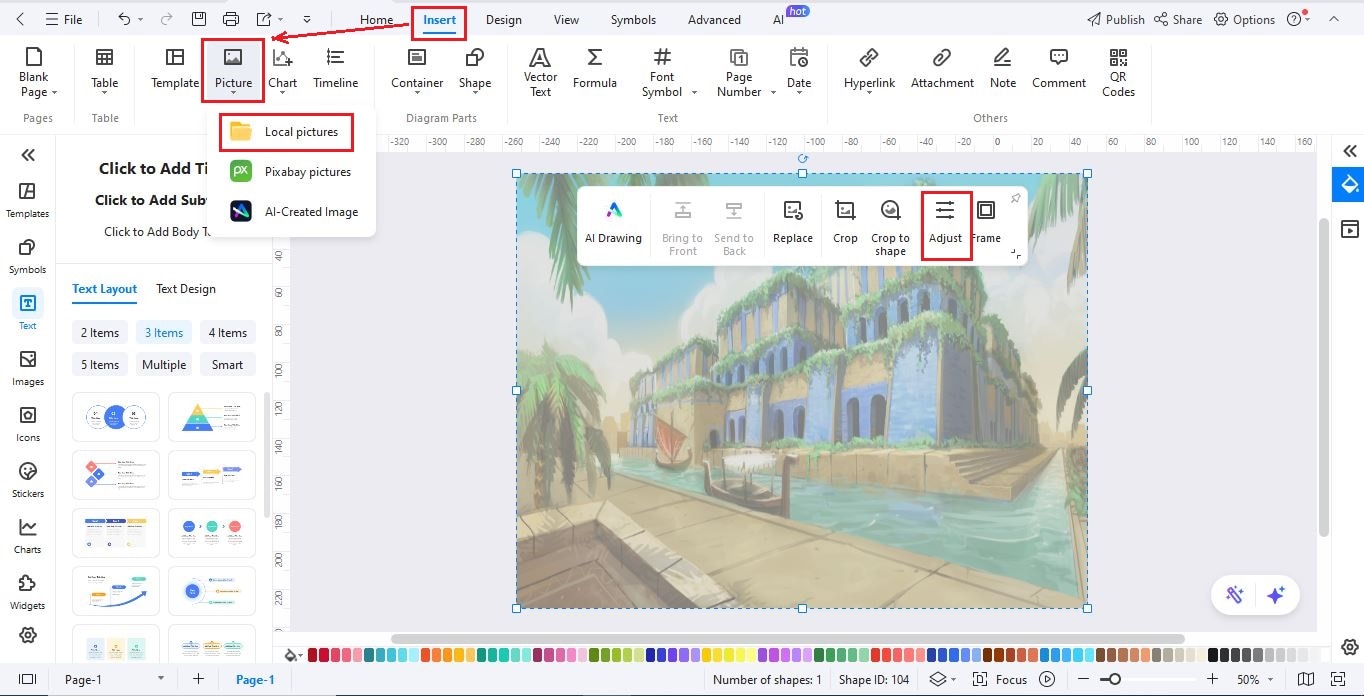
Step3Insert a Timeline Title
- Add a title, such as “Babylon Empire Timeline,” using either text or an image. For this example, we'll use text.
- Click Text and then Click to Add Title to insert your chosen heading.
- Enhance the visual appeal by adding relevant icons, such as stars, cuneiform symbols, or depictions of ancient temples.
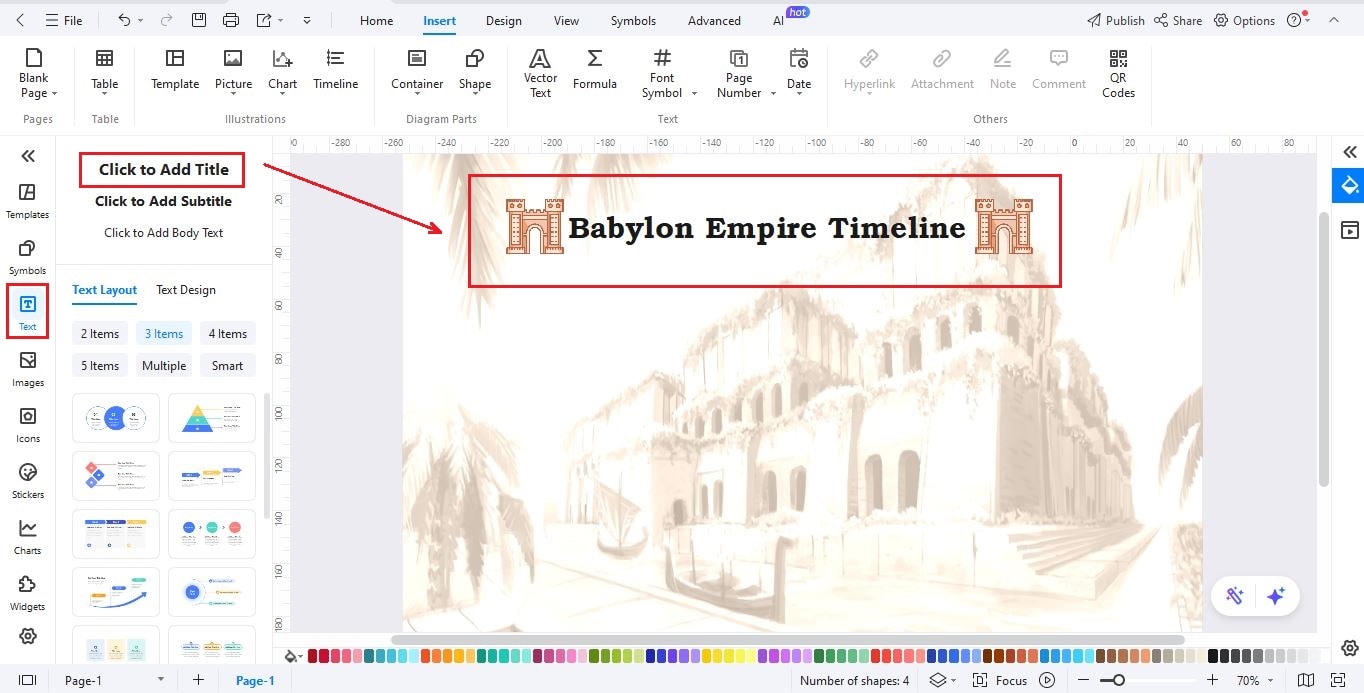
Step4Insert the Timeline Layout
- On the top menu, go to Insert and select Timeline.
- Choose a Vertical Timeline template that includes image placeholders, then click OK to insert it onto your canvas.
- Click on the timeline to access a toolbar where you can customize its structure to accurately reflect Babylon's chronological history.

Step5Add Key Babylon Events
- Click Text on the left editing panel.
- Use Click to Add Subtitle to label each era or ruler.
- Then use Click to Add Body to provide concise descriptions of each major event, king, or significant achievement.
- Repeat this process for all the events you want to include.
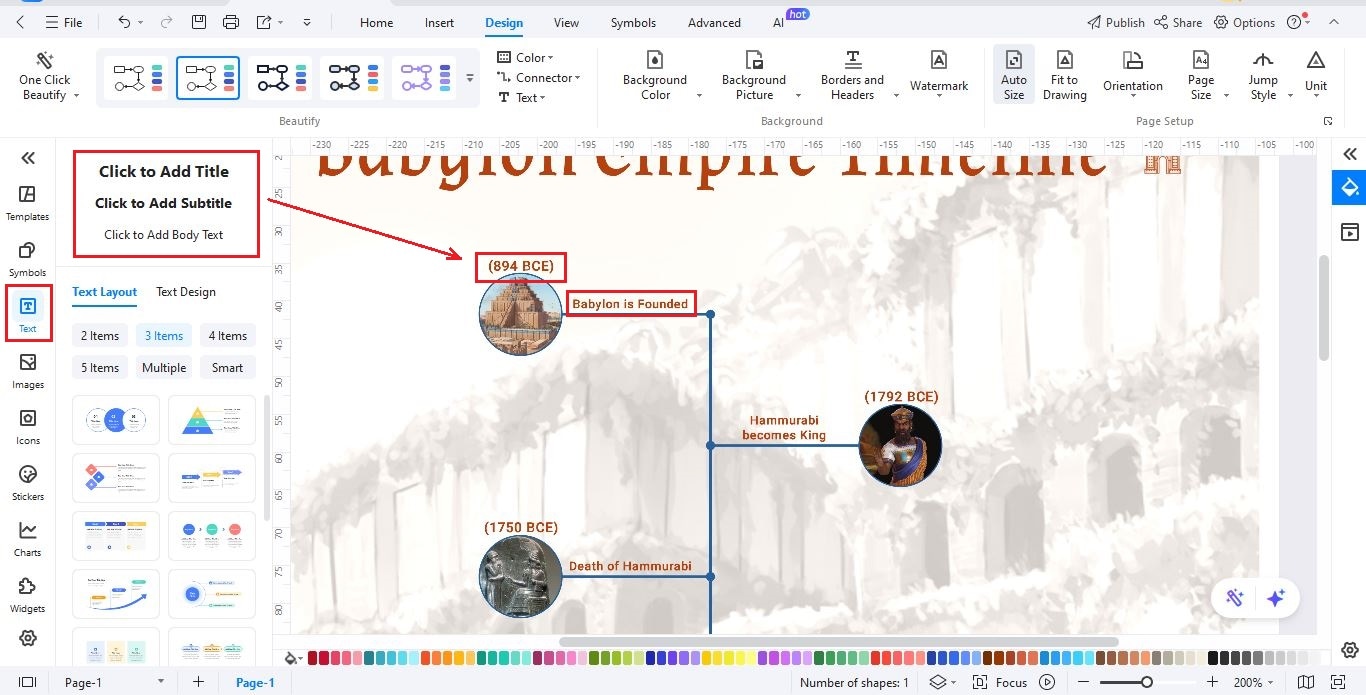
Step6Insert Milestone Images
- Go to Insert > Picture > Local Pictures and upload visual elements, such as images of Babylon's iconic walls, towering ziggurats, influential kings, or significant artifacts.
- Click an image, choose Crop to Shape, and select a frame style that complements your timeline's overall aesthetic.
- Repeat this for each milestone to create a visually rich and engaging timeline.
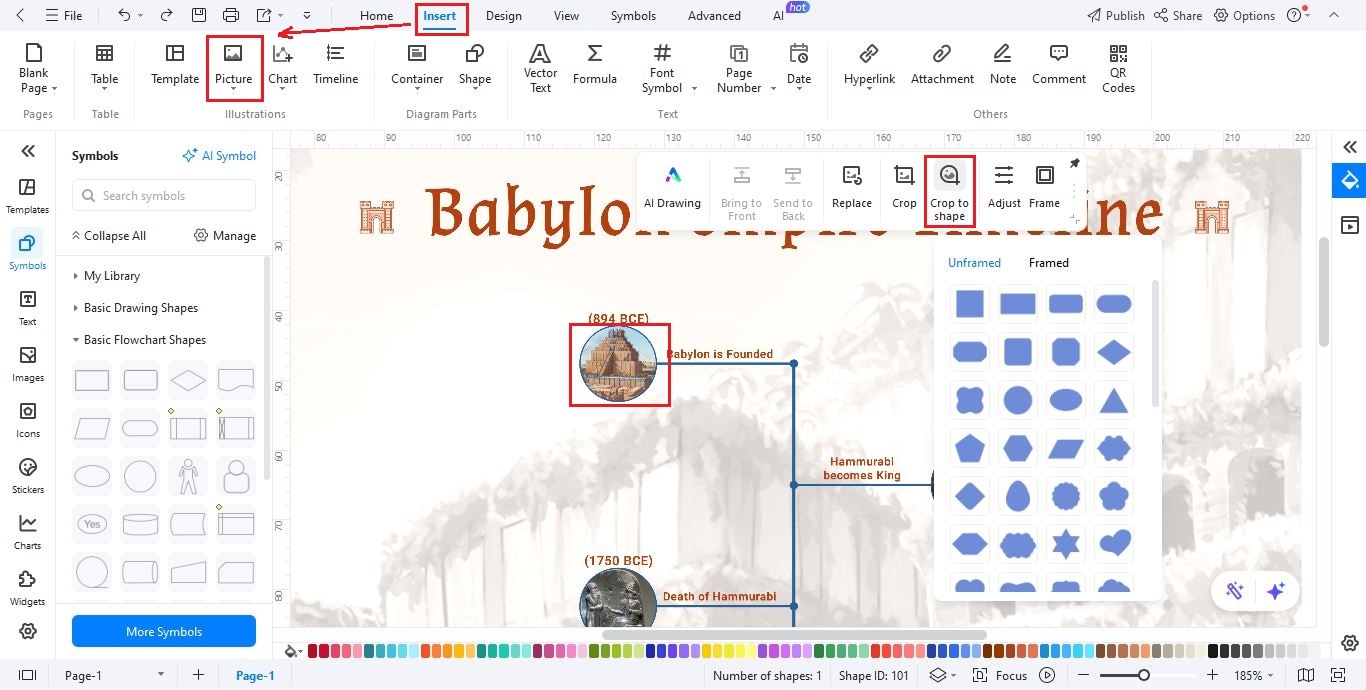
Step7Save and Share Your Timeline
- Once your timeline is complete, click File > Save to retain an editable version for future modifications.
- To share your creation, go to File > Export and select your desired file format, such as PNG, PDF, SVG, HTML, Visio, or Excel.
- Click Publish to showcase your timeline to the EdrawMax community and beyond.
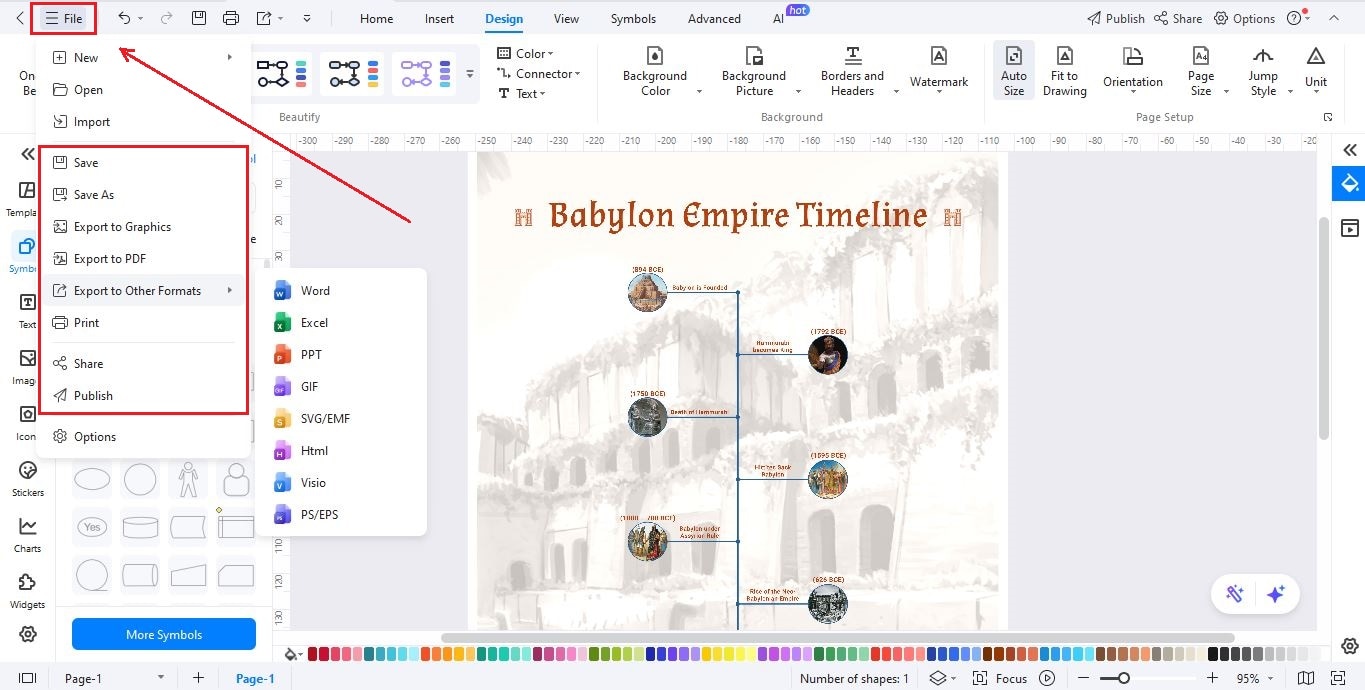
Final Words
From its humble origins as a small settlement along the riverbanks to its reign as one of the most celebrated cities in the ancient world, Babylon's journey is a testament to human ingenuity and resilience. Visionary leaders like Hammurabi and Nebuchadnezzar II transformed the city into a beacon of power, commissioning the construction of impressive walls, magnificent temples, and the breathtaking Hanging Gardens. Despite facing periods of conflict and decline, Babylon consistently maintained its status as a vital center for learning, religion, and culture, leaving a lasting impact on subsequent generations.
To fully appreciate the grandeur and complexity of Babylon's story, consider creating a visual timeline using EdrawMax. This intuitive tool empowers you to create clear and engaging charts that illustrate the rise and fall of empires, making history accessible and captivating for everyone.





